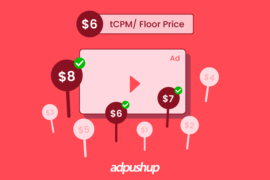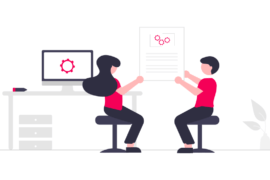Placing advertisements on your website or blog is one of the easiest ways to generate revenue. Whether you’re using a program like Adsense or you have individuals or companies who pay directly to place ads on your site, you can earn a good steady income by simply keeping your site updated and active. When it comes to earnings from advertisements, however, you can’t make money if people don’t stay on your site long enough or leave your website without exploring further (which also increases your page views and ad impressions) to see the ads and consider clicking on them. When people arrive at your site and either click the back button or browse to another site without opening a second page on your website, it is called bouncing.
The bounce rate is the percentage of people who arrive on your page and leave without navigating to other pages of your website. While it is virtually impossible to eliminate it, there are ways to reduce bounce rate significantly. When it comes to increasing the ad revenue, focusing on lowering your bounce rate is extremely important. Many would argue that a good strategy to lower the bounce rate is even more important than good SEO because no matter how many people click on your link from the search engine results page, if they immediately browse away, you’ll never make a dime. Moreover, As you can see from #76 of the 200 factors which google considers when ranking websites, site usability i.e. higher average time spent, lower bounce rate and higher page views per visitor, actually help your Search Engine rankings too.

Finding Your Bounce Rate
If you don’t already know what the bounce rate for your site is, then that’s the first step you need to take. This is an extremely simple task which anyone can do in just a few minutes. One of the easiest ways to view and track your bounce rate is to install some sort of analytic tool, the most common being Google’s Analytics. This is a free tool which will track a lot of information about your site, its visitors and of couse, the bounce rate. Signing up is quick and simple, and you can have it start tracking information about your site by simply adding the analytics – javascript code on your website or using a plug-in for your CMS.
Depending on the type of site you run and where your traffic comes from, your bounce rate is likely to be somewhere between 25% and 75%. The lower the number, the better your doing. Make sure you write this number down or learn how to run historical reports so you can always track whether your bounce rate is going up or down based on the changes you make to the page. Also remember that if your site is new or doesn’t get much traffic, then it is hard to accurately track the bounce rate because a single user can dramatically change the results. In short, when testing and comparing changes done to the page, you won’t achieve Statistical Significance, due the low traffic volume. These statistics are really only beneficial once you’re getting at least 50 or more visitors per day.
What is Causing Your Bounce Rate
Now that you have a benchmark of what your bounce rate is, you can start taking steps to reduce it. There are many factors due to which people stop reading or close a page, so it might take some time and effort to discover what exactly it is about your site that causes people to quickly browse away. The following are a few of the most common reasons which can affect a site’s bounce rate, and some tips on how to fix those issues.
- Poor Content Quality – This is the reason why websites with spun content, have a high bounce rate. Visitors start reading the content, it makes no sense and BAMM, the tab is closed. Similarly, if your content is not interesting or not written well, your bounce rate will be higher than it should be. You can start with a small test. Pick a page on your site which has the highest bounce rate, hire a professional copy writer, change its content and let the data talk with you.
- Traffic Source – If someone arrives to your site thinking it is a blog about saving endangered whales, but discovers at first glance when it loads that it is actually about how to hunt whales, you just lost that visitor. So, If you’re getting any sort of paid traffic, make sure you’re keeping a close eye on the keywords, which you are paying for. Similarly, read this post about the google webmaster tools, you can see which organic keywords are sending traffic your way ie. If you’re only using SEO for traffic, review your site closely to see what terms you are ranking for. If they are the wrong keywords, rework your SEO Strategy. The Google webmaster tool can be linked with your Analytics tool to get in-depth information about this.
- Site Layout – The internet today is so massive that people demand high quality content and pages everywhere they go. If your page has obtrusive colors, overall poor design/UI; visitors will simply hit the back button. Even though the goal of your site is to generate revenue through advertisements, you really need to focus on the user experience to ensure they stay on your site long enough to actually see the advertisements. If you change the layout of your site to a Christmas theme during December you might see a drop in the bounce rate, for example. If you use bold headings it might trigger people to browse away if the heading is also blue, but not if it is black. There are endless combinations of tests which you can run to find the ideal site layout for you.
- Pop-Ups & Other Advertisements – As mentioned in the previous point, many people browsing the web today feel overrun with advertisements, especially those that pop-up or pop-under the page. If you are using popups, in anyway, make sure your remove them straightaway! Advertisements can be good to, if relevant, but make sure they are well placed and not intrusive to the overall user experience. You can always A/B test different ad designs using our ad revenue optimization tool – Adpushup. Similarly, you can apply at relevant ad networks, which focus on delivery high quality and relevant creatives.
- Speed of the Site – When people click on a link to your website, from the search engine results pages, they want your site to load up quickly. If your site partially loads and then takes even just four or five seconds to finish, many people will close the tab and look at the other pages they opened. Internet users are a demanding group and they want their information NOW. If your site is taking more than two or three seconds on average to load, work with your web hosting company to get this improved; or start using a Content Delivery Network (CDN).
- Audio – Using an auto playing sales pitch or any other audio, on your website, is a big NO.
- Poor Mobile Site – Having a mobile version of your site or a responsive design can really work wonders. Otherwise, you are losing the traffic from mobile users. With over 50% of American adults owning a smart phone it is no surprise that a growing percentage of all web traffic is directed towards mobile sites. Make sure your website loads quickly and displays properly on all smart phones and tablets.
- Website Compatibility – If your website shows up broken on any of the top 5 Browsers (Chrome, Firefox, Safari, Internet Explorer & Opera), it is a matter of concern. This is one of the top reasons why people close website.
- Wall of Text – No matter how good or informational a site is, if your page loads up and displays nothing but text it will be daunting to the reader. Break the site up using related images and links to other areas of your site. Using bullet points and sub-headings can also help make your site seem less intimidating and should help to reduce the bounce rate as well. So, a well organize page can help reduce bounce rate.
- No Headings – When people are looking for specific information or content they want to be sure they are on the right page before they actually start reading it. If you don’t have bold headings which give an accurate introduction to what people will be reading and how they will be benefited reading it, they might just browse away looking for a site which is more likely to give them exactly what they want.

How to Reduce Bounce Rate for your website
One of the difficult things about running a website is that there isn’t a single solution to most problems. What works well for one site might actually make the bounce rate worse for another page. This can be extremely frustrating for many webmasters who are attempting to lower their bounce rate by following the advice of experts and doing what is covered in a lot of case studies. While it is a great idea to read what other people have to say about reducing the bounce rate, in the end you’ll have to just experiment with your site until you find what works. Starting with common problems and solutions suggested by your website visitors (feedback) is a great idea, but don’t be afraid to go with your gut feeling sometimes as well, and then use website testing to see if the data speaks the same language.
Looking through the above list of problems which cause bounce rates to go up is another great way to lower your bounce rate. Taking the time to go through each of those items and making necessary changes will help eliminate some of the most common problems. In the end it is going to be a matter of learning new things, implementing changes and seeing what works for your specific site. Every site is different, so find what works for you and go with it.
Before you take any type of action to reduce your overall bounce rate it is important to understand that everything you do is only a test. The best way to find out what works best is to come up with an idea that you believe will reduce the bounce rate of your site, and then make that change. Leave the variation running for a few days or until you reach statistical significance, before comparing the results. This is known as split testing and can be a great way to find out what is working best.
It is also possible to have your site automatically direct half (or any other percentage of visitors) to one version of your site, and the other half to the updated version. Depending on the amount of traffic your site gets these types of tests should be initiated for anywhere from 24 hours to one month to ensure the information is accurate and not just a fluke based on one or two visitors.
- Custom 404 Pages – Everyone hates seeing a 404 Page. When your website visitor comes across a 404 error, the most likely thing to happen is that the visitor will close the window. Instead why not use this as an opportunity and present the visitor with a custom 404 page and show them other links on your website. Depending upon your website, you can show your most popular services/products or your most popular website pages.
- Split longer posts – If you have a long piece of content, considering dividing it onto multiple pages and show the “Next” and “Previous” Buttons prominently. If your content is interesting, it can really help reduce bounce rate on your website.
Complex Solutions
When you run a split test on your site and find that a change you made helped your site’s bounce rate drop by a few percentage points it is a real cause for celebration. Don’t think the work is over though, because for a successful webmaster, this should be an ongoing process that literally never ends. If you change the layout of your website and the bounce rate drops by 5%, for example, you can then try altering the color scheme of the site and see what happens next. If you can reduce the bounce rate even further, this means larger number of page views, better Search Engine rankings, more impressions and more ad clicks.
Tracking Your Tests
If you are testing the bounce rate manually, make sure you don’t run multiple variations at the same time. This will help you keep track of what worked and what did not effortlessly, instead of any confusions.
Why Reduce Bounce Rate?
While it is obvious that when you have a lower bounce rate there will be more people who browse more pages of your site. When they browse around to different pages within your site they will be viewing more ads, increasing the chances that they will click on one. If you’re running advertisements for which you get paid on a CPM basis, every page they view will be earning you a small amount of cash. So, reducing bounce rates can be a even better for CPM Publishers.
This, of course, is the obvious benefit of reducing your bounce rate, but there are other key things to keep in mind as well. If a visitor takes the time to read through your landing page, and possibly even visit other pages on your site they are far more likely to share it with their friends, or “like” the page on Facebook. The longer people stay on a particular site, the more likely they are to come back again in the following days or weeks. Getting individuals who come back to your site frequently is extremely valuable and can lead you to become an authority in your niche and of course, dramatic increases in revenue from the advertisements too.
If your site gets enough traffic, and you have a low enough bounce rate you can often increase the amount you charge to companies who want to place an ad on your page. By showing them that you have hundreds or thousands of visitors who come back frequently you will be proving to any marketing expert that you have the trust of the community, which your site is targeting. This is extremely valuable to marketers, and they will often pay top dollar to put their advertisement on such site.
While it may seem overwhelming at first to go through the process of learning about your bounce rate, discovering what types of things might be causing it to be higher than it should be, and performing tests regularly to reduce it, is well worth the effort. For sites with a significant amount of traffic a reduction of the bounce rate by even just 1% can result in thousands of extra dollars being earned each month. The same is true for smaller sites, but on a smaller scale.
Making little changes and adjustments and seeing sometimes dramatic results can be exciting, and seeing the increased income your site is generating is, of course, going to be one of the best feelings in the world.
Ankit is a co-founder @ AdPushup (a tool which helps online publishers optimize ad revenues) and loves online marketing & growth hacking.






